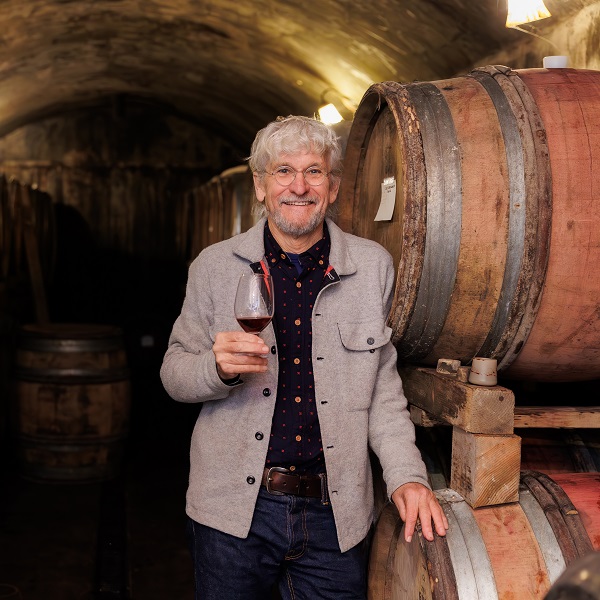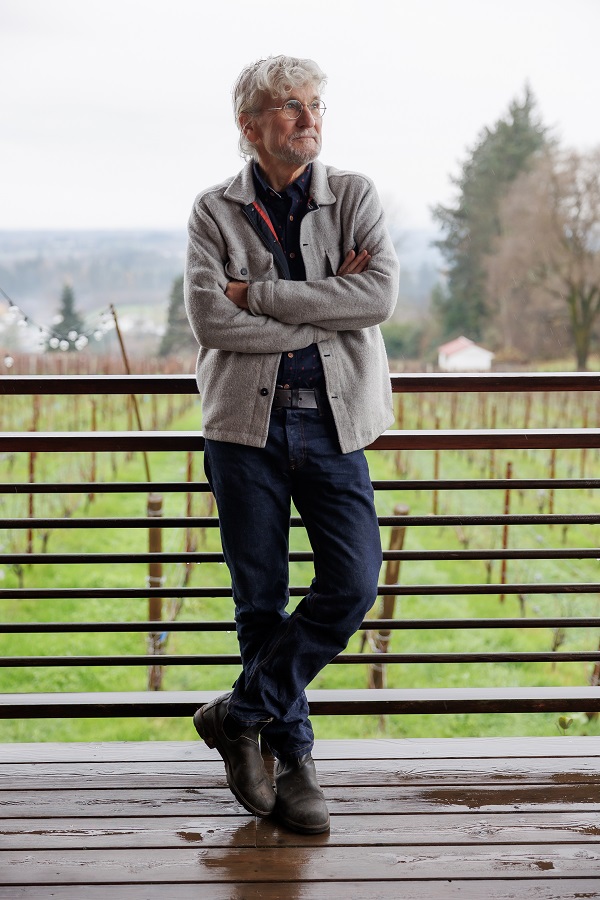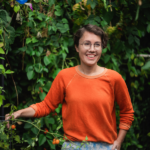The Wizard of Worden Hill
Written by Joe Wilkins; Photographed by Daniel Stark
A gray sky hung low over the Red Hills of Dundee, over the leafless November orchards and long, sloping vineyard rows. The gravel driveway crested the hill, and I parked near a small solar array and climbed out. Rain fell slowly, more mist than rain, a fog, a miasma—just the kind of weather, I thought, turning up my collar and crunching across the lot, to meet a wizard.
The top of the hill, even under cloudy skies, offered astonishing views of the valley and the Coast Range, yet the facilities were unpretentious, clearly built for the work of growing grapes and making wine. The Carhartt-wearing vineyard manager let me in, then fired up the forklift and set himself to organizing pallets of Pinot and Chardonnay. I turned a corner—and there he was, the Wizard of Worden Hill himself, owner and founder of Cameron Wines, John Paul.
White-haired and wearing a trim white beard, John greeted me warmly and, as if by magic, produced two wine glasses, then hustled me down the steep stairs to the cellar. John Paul led me ever deeper in, and there’s no other word for it—the cellar at Cameron Wines is funky, and I mean funky as measured by all five senses and then some: dark, cool, and humid, a dank swirl of smells struck my nose as we slipped between stacked oak barrels and ceramic amphora and stainless steel fermenters, the stone walls laced with splattery molds and fungal threads. In an attempt to mimic the ancient cellars of Burgundy, John explained, he sprayed beer all over the brand-new walls, in ’86, to seed the cellar with a healthy, place-based microbiology. “The health inspector from the Department of Ag,” John said, laughing, “he didn’t understand. He was really pissed!”
We made it to the cave, an off-shoot of the cellar with a low, arced ceiling of stone—just the kind of place for a candle-lit medieval feast, or a dark dungeon—and John plunged a thief into a barrel of 2022 Abbey Ridge Pinot and splashed some into both our glasses. We admired for a moment the rich, lustrous purples and deep reds, then tasted. “This has black fruit, plum and prune,” John explained. “One of the things you look for at this point is how it feels in the mouth. This one covers the palette, and has some interesting texture to it.” While John was pleased, he planned to give these barrels at least another year, maybe more, before he and his team started blending. I, on the other hand, would have liked another taste right then. This young Pinot was magic in the glass.
Forty-five years ago, wishing to use his right brain as much as his left, John Paul said goodbye to a burgeoning career in marine biochemistry to try his hand at the art of making wine. After stints at wineries in his native California and in New Zealand, and on the advice of a mentor in Napa, he pointed his nose north, to Oregon, in the early ’80s. At the time, though grapes were growing and early pioneers in the industry were making great wine, Oregon had barely been mentioned in Wine Spectator. John Paul wasn’t deterred. With the help of his wife, Teri Wadsworth, as well as support from a number of partners, and with a Volkswagen load of cuttings taken from some of the oldest Pinot Noir and Chardonnay vines in California, many of which had in turn come from Burgundy in the 1890s, John Paul set out to make wines in the true Burgundian manner—on a hill in Oregon.
And he has. From New York State to Napa, Cameron Wines are now recognized as some of the finest in production across the past decades. But it’s not wizardry, John assures me. It’s his deep respect for tradition, for the wisdom of the ages. He asks questions, he listens, and he’s not afraid to try something new—or, rather, something very, very old. When John was first starting out, for instance, he questioned some winemakers from Burgundy about how to deal with the many clones, vines propagated from a single parent plant for specific qualities, in his vineyard. Should he pick them separately, then blend later, which was the style in the States at the time?













































